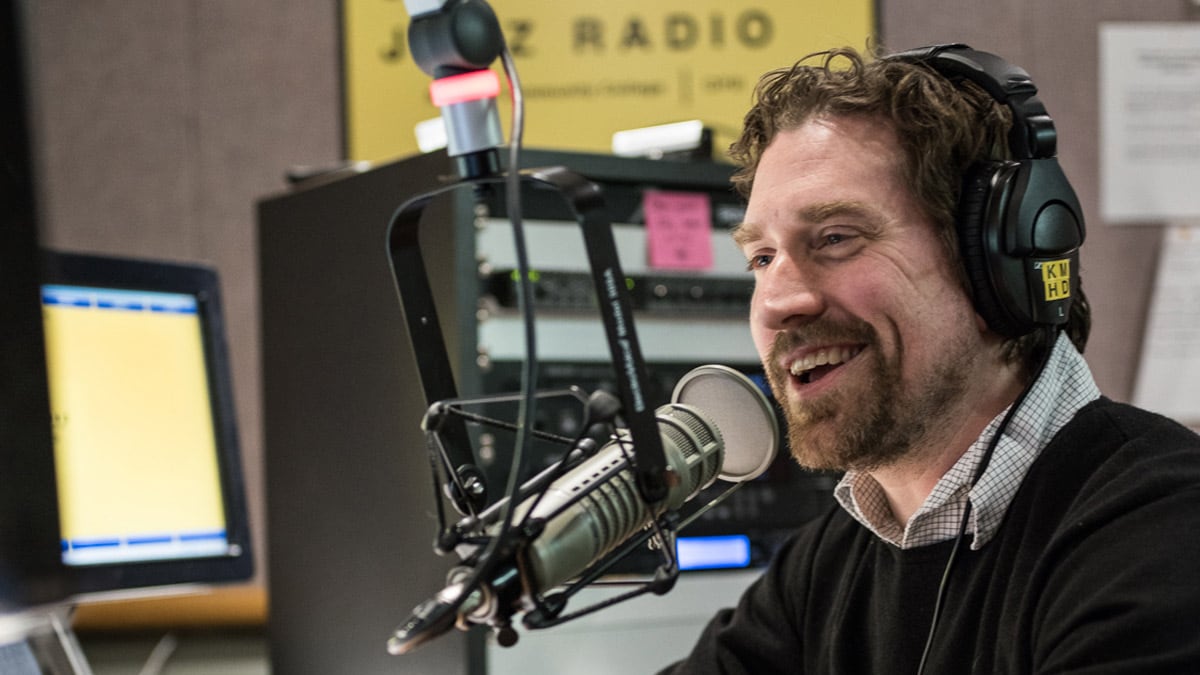This is the second in a four-part series covering the past, present and potential future of jazz in Portland. Read our first article, surveying Portland's defunct jazz clubs, here.
The minute hand ticks to meet the hour hand at noon, and from a closet-sized room with off-gray carpeting in Southwest Portland, Matt Fleeger begins talking to himself.
“Happy Wednesday afternoon,” he says into a rust-colored boom mic, introducing the latest edition of KMHD’s New Jazz for Lunch program. Not one to obscure his sets with chatter, Fleeger, in his modulated tenor, simply says, “Today, we kick off the show like this,” leading straight into pianist-composer Javi Santiago’s “Trance.”
The sparse, riff-based tune featuring a drum kit and organ soothes as much as it hooks, which is a good descriptor of the station whose airwaves it occupies. Founded in 1984, KMHD (89.1 FM) is one of the nation’s oldest listener-supported radio stations. In recent years, it has gained national prominence among jazz stations, being named Station of the Year by JazzWeek magazine in 2012.
Although Fleeger would never gloat about it, a majority of that growth is because of his work as KMHD’s program director. He’s been with the station since 2009, the same year it changed hands from Mt. Hood Community College to a partnership with Oregon Public Broadcasting. Fleeger’s daily lunchtime program of new releases is just one facet of the identity change the station has gone through under his leadership.
Off the air, Fleeger's voice is more adenoidal and naturally excited. When he talks about music, he gesticulates from his wrists. When he listens, he mostly pulls at his beard. His face is long and slim, and he seems always to be wearing a black crew neck.
“Skateboarding and Fugazi are really the two things that got me into jazz,” he says, somewhat out of left field, citing seminal street skateboarder Mark Gonzales’ 1991 skate video Video Days and its John Coltrane soundtrack as the exact moment that sparked his interest. “I started dabbling. I’d go to the record store and buy a tape by a jazz artist, as well as the Black Flag tapes I was buying.”
It wasn’t until 2002, though, when he started working at jazz radio station KRTU in San Antonio, that Fleeger became “fully immersed” in jazz. This may make him seem an off-kilter choice to lead a major jazz institution, but the narrative of Fleeger’s relationship with the music—stumbling upon it in conjunction to music he already loved, developing a curiosity and eventually falling hopelessly in love with it—is exactly what KMHD hopes its listeners will experience.
“We’re not necessarily here to serve that hardcore jazz audience,” Fleeger says. “They typically tend to be collectors of music, people who go out to live shows, things like that. They can tune into us when they want to. Our real aim is to reach people who don’t think they like jazz and show them that they do.
“I love it when somebody says to me, ‘I don’t like jazz,’ because I’ve never had an instance where someone’s told me that…and I couldn’t turn them onto it.”
Fleeger’s knowledge of jazz is indeed encyclopedic, even joyfully so. He tacks on dates, names and associated facts that seem plucked from an infinite mental database, and the exactitude is surprisingly humanizing. Instead of complaining that jazz traditionalists have sticks up their asses or are stuck in the past, he says, “It is true that some of the greatest jazz ever made was made in 1958,” but then “jazz kind of stops for them in 1968, when Miles Davis goes electric.”
Although KMHD’s 6 am-to-6 pm weekday blocks are filled largely by straight-ahead acoustic jazz, there’s plenty of evening and weekend programming real estate left to the station’s specialty shows. Going by their names—Beat Parlor, Soulful Strut, Blues Before Sunrise, The Brazilian Beat—they touch on what Fleeger calls jazz’s “connection points,” with hip-hop, world music, soul, funk, house, pop and every imaginable pit stop in between.
“In fact,” Fleeger says, “we don’t even really want to get into that space where we say, ‘This is jazz and this isn’t jazz.’”
Niche genre consistency is often the name of the game in music radio, but KMHD’s free-associative flow from one jazz idea to any number of off-jazz ideas has literally doubled its audience. When Fleeger took over as program director, the station averaged between 60,000 and 70,000 listeners per week. Now, the weekly average is up to almost 150,000, with 30 percent of those listeners falling in the 12-to-24 age demographic.
“Clearly, it’s a situation where more young people are becoming involved in the station,” he says. “But what we’ve found, is that the hardcore jazz audience hasn’t really left KMHD. They may not like everything we play, but we’re still playing some of the things they love.”
And besides, Fleeger says, the only thing that could divorce KMHD’s spirt from the spirit of jazz would be for it to stay stagnant and purist. As he puts it, “The people that jazz history tends to forget are people who do not innovate.”
